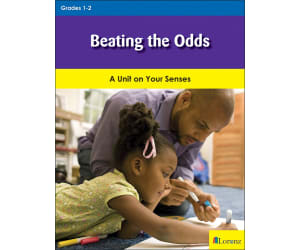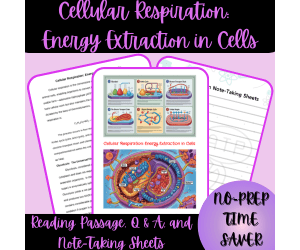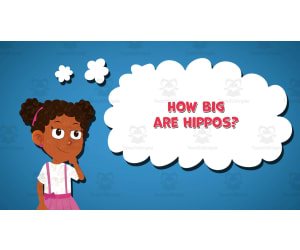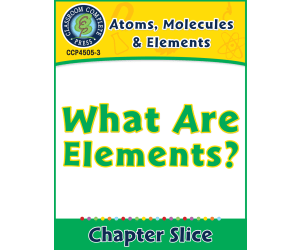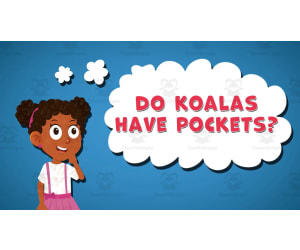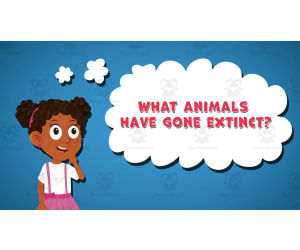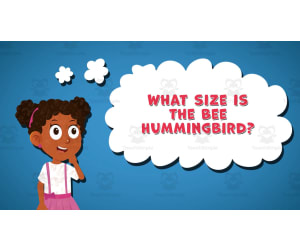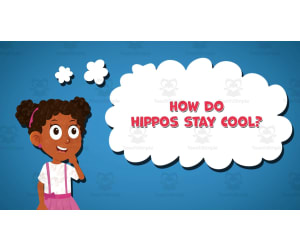2,788 products added recently
Biology Lesson Plans
Delve into the study of life with lesson plans that bring biology to life in your classroom. From cell structures to ecosystems, these resources offer hands-on activities and discussions that deepen students' understanding of biological concepts. Incorporate these plans to promote critical thinking and appreciation for the diversity of living organisms.
Beyond the Jack-o'-Lantern Reading Passage and Q & A
ELA, Reading, Writing, Holiday & Seasonal, Resources for Teachers, Science, Life Sciences, Biology, High School, Homeschool Resources, Teacher Tools, Assessments, Lesson Plans, Quizzes and Tests, Worksheets & Printables, Writing Prompts
You know how it is as a homeschool mom - you are constantly on the hunt for something that will actually grab your teenager's attention for more than five minutes! Well, Beyond the Jack-o'-Lantern: The Biology and Culture of Pumpkins totally surprised me. I thought it might be just another fall-themed busy work packet, but wow, was I wrong. INCLUDED IN THIS RESOURCE: A detailed, multi-paragraph reading passage exploring pumpkin biology, history, culture, and nutrition. 20 higher-order thinking questions with an accompanying answer key for guided support. Printable note-taking and graphic organizer sheets to strengthen comprehension and study skills. Teacher-friendly design with easy-to-use formatting for both classroom and homeschool environments. TOPICS COVERED: Plant biology, anatomy, and the growth cycle of pumpkins. Ecological interdependence with pollinators and sustainable agriculture. Historical and cultural significance of pumpkins across societies. Nutritional benefits and interdisciplinary applications in STEAM education. My daughter picked this up thinking she'd breeze through some pumpkin facts, and before I knew it, she was down this rabbit hole learning about plant biology, cultural traditions, and agricultural history. She did not even complain once! (Trust me, that is saying something with a 9th grader.) What I love is that she has no clue she's doing this fancy "cross-curricular" learning - she is just genuinely fascinated. And can I just say how nice it is when a resource does not require me to spend hours figuring out how to teach it? Everything flows so naturally from one topic to the next. The other day she came to me with this question about how pumpkins spread to different continents, and I am thinking, "When did my kid start caring about agricultural migration patterns?" It is these moments that remind me exactly why we chose to homeschool. Taking something as ordinary as a pumpkin sitting on our porch and turning it into this amazing learning adventure - that is the good stuff right there. Sometimes the best lessons come from the most unexpected places! If you and your students/homeschoolers enjoyed this resource, please leave a review. Thank you for your support! Tina - Big Easy Homeschooling Mom
Author Homeschool with Big Easy Homeschooling Mom
Rating
Tags Pumpkin Biology, Pumpkin Culture, Homeschool Science Resource, High School Pumpkin Lesson, History Of Pumpkins, High School ELA Science Unit, Pumpkins In History And Culture, Cultural Traditions Pumpkins, Interdisciplinary Pumpkin Unit, Cross-curricular Pumpkin Unit
Ecosystems: Food Chains and Webs
Science, Life Sciences, Biology, Common Core, Grade 5, 6, 7, 8, Teacher Tools, Lesson Plans
Ecosystems: Food Chains and Webs A teacher's resource that emphasizes the biotic and abiotic aspects of our ecosystems making it an indispensable tool for educators looking to explain the intricate relationships between Producers, Consumers, and Decomposers. The main objectives of this teaching resource are: Help students understand how populations evolve Explain changes in ecosystems over time Elucidate the dynamics of food chains and food webs Simplify complex concepts like Photosynthesis back to water cycle links etc. This guide is packed with ready-to-use information to engage students in vibrant science lessons . The simplified language used carves out intricate scientific studies into interesting bits relayed through accessible vocabulary makes it perfect for students needing remedial instruction. It even has engaging reading passages underpinning key points drawing them further into engrossing scientific explorations. Ecosystems: Food Chains and Webs Additional Features Incorporates student activities paired with colorful mini posters doubling up as visual aids perfect for class settings irrespective if its a whole group discussion or small buddy group studies or even independent work. Meticulously designed, adheres strictly with Common Core State Standards also incorporates Bloom's Taxonomy educational objectives plus standards set by STEM initiatives ensuring assured quality content. The materials tackle: -Primary target being grades five through eight –Biology subtopics focusing mainly on ecosystem studies This makes it a vital asset within Science Lessons Plans Available in convenient PDF format ensures making this material readily available marking itself as a pivotal aid helps teachers kickstart gripping biology lessons about ecosystems reaching right down into its very life threads – the food chains and webs.
Author Classroom Complete Press
Tags PDF
Beating the Odds: A Unit on Your Senses
Science, Life Sciences, Biology, Grade 1, 2, Teacher Tools, Lesson Plans
Beating the Odds: A Unit on Your Senses, is an engaging educational resource meticulously developed for educators seeking to explore the intriguing world of human senses with their maturing learners. Designed precisely to meet the learning requirements of grades 1 and 2, this all-inclusive unit intends to introduce biology as a significant sub-discipline within science. The resource comes as a convenient PDF file encapsulating seven systematically organized pages overflowing with enlightening content, including: A nonfiction article focused on Helen Keller Inspirational story showcasing her victory overcoming immense sensory difficulties. Carefully crafted worksheets providing extensive understanding beyond simple reading or lecture-based lessons. The Beating The Odds: A Unit On Your Senses can be utilized in divergent teaching scenarios such as: Solo-study assignments at home or in remote settings, Small group endeavors during classroom breakout sessions, Full-class instruction via whiteboard presentations or group discussions. This flexibility allows educators various options of incorporating it into their unique teaching strategies based on defined classroom dynamics and specific student needs. Cruising with modern-day academic necessities while honoring traditional values regarding quality and pertinence—"Beating The Odds: A Unit On Your Senses" readies teachers to enlighten young minds for future explorations today.
Author Classroom Complete Press
Tags Science, Senses, Helen Keller, Sign Language, Puzzles
Life Cycle of a Watermelon Worksheet | Plants & Fruits Unit Study
Summer, Seasons, Holiday & Seasonal, Montessori, Life Sciences, Science, Biology, Nature & Plants, Kindergarten, Preschool, Grade 1, 2, 3, Bulletin Boards, Classroom Decor, Posters, Lesson Plans, Teacher Tools, Flashcards, Worksheets & Printables, Coloring Pages, Worksheets
Have you ever wondered how a tiny seed grows into a big, juicy watermelon? In this fun and interactive science unit, we will explore the amazing life cycle of a watermelon and discover fun facts about this delicious fruit. Get ready to learn, cut, paste, and color! What’s Inside Watermelon Fun Facts – Learn where watermelons grow, how they develop, and why they are so refreshing! Life Cycle Diagram – A simple and clear chart showing each stage of a watermelon's life, from seed to fully grown fruit. Cut-and-Paste Activity – Arrange the life cycle in the correct order by cutting and pasting the stages. Flashcards – Use these picture cards to remember each step in a watermelon's journey. Bonus Coloring Page – Get creative and color a bright, tasty watermelon! You can use this worksheet for: Makes learning about plants and fruit fun and interactive. Helps develop sequencing and problem-solving skills. Teaches the importance of plant growth and agriculture. Includes hands-on activities to reinforce learning. Let’s dive into the world of plants and discover how watermelons grow!
Author Perfect_Printables
Tags Watermelon Life Cycle, Fruit Unit Study, Watermelon Activities, Life Cycle Worksheets, Science Printables, Homeschool Science, Fruit Biology Lesson, Watermelon Theme, STEM ActivitieSTEM Activitiess
Classification & Adaptation: Evolution and the Fossil Record Gr. 5-8
Science, Life Sciences, Biology, Grade 5, 6, 7, 8, Teacher Tools, Lesson Plans
Classification & Adaptation: Evolution and the Fossil Record Gr. 5-8 Classification & Adaptation: Evolution and the Fossil Record Gr. 5-8 is an excellent teaching resource intended for students from grade 5 through grade 8. This comprehensive guide breaks down complex concepts into simpler, more understandable formats, with an initial focus on the basics of classification such as distinction between warm-blooded and cold-blooded animals, vertebrates, and invertebrates. Case studies are provided to illustrate these intricate scientific concepts clearly. An entire section of this guide is dedicated to evolutionary science along with useful guides on understanding fossil records. Hands-on Learning In addition to providing detailed explanations of scientific topics this teaching resource also includes hands-on activities designed to engage students further: 'How Important Are Thumbs?': A practical experiment which allows learners firsthand experience of our thumb's importance. The Lake Habitat Thermometer: An ecosystem-based activity that helps understand environmental dynamics better. A Day in the Life of a Paleontologist: Designed especially for aspiring paleontologists that involves digging up 'fossils' from prepared excavation sites similar real-world scenarios. Beyond Just Full-class Instruction! This resource has been designed keeping adaptability in mind which permits its application beyond just whole class instruction but also encourage small group interactions or independent study based on learner aptitude or teacher preference. An inclusive range of challenges per exercise promote both fundamental comprehension amongst remedial learners as well as advanced concept delving amongst high-level achievers. Standards Alignment Classification & Adaptation: Evolution and the Fossil Record Gr. 5-8 is meticulously aligned with state standards and supports Blooms Taxonomy's cognitive development areas as well as placing emphasis on STEM initiatives especially focused on Science proficiency. Auxiliary Study Materials This product also provides complementing written materials like reading passages apt for this grade level along with test preparation exercises that help promote both factual recall abilities and critical thinking skills in learners thereby improving overall academic performance over time. In essence, Classification & Adaptation: Evolution and the Fossil Record Gr. 5-8 presents a wholesome teaching aid that any educator - be it public school teachers or homeschoolers would find beneficial for their biology curriculum. The complete guide comes in a convenient PDF format providing robust yet interactive instructional material!
Author Classroom Complete Press
Tags PDF
Cellular Respiration: Energy Extraction in Cells Reading Passage
ELA, Reading, Writing, Research, Resources for Teachers, Science, Biology, Life Sciences, High School, Homeschool Resources, Teacher Tools, Assessments, Quizzes and Tests, Lesson Plans, Worksheets & Printables, Writing Prompts
Teaching cellular respiration can feel overwhelming, especially when you want your students/homeschoolers to truly understand how cells create energy, not just memorize steps. As a homeschool mom guiding my own ninth grader, I know how important it is to have resources that break down complex topics into manageable, engaging pieces. That is why I created this Cellular Respiration: Energy Extraction in Cells Reading Passage, Q & A, and Note-Taking Sheets resource, complete with a detailed and complex reading passage, thought-provoking questions, and five versatile note-taking sheets. Designed for high school/homeschool biology, this resource helps students/homeschoolers grasp the big picture of cellular respiration while also encouraging critical thinking and independent learning. Whether you are teaching at home or in a classroom, you will find this resource to be a practical and effective addition to your curriculum. INCLUDED IN THIS RESOURCE: Multi-page, detailed Cellular Respiration Reading Passage 20 critical thinking passage questions A comprehensive answer key 5 flexible note-taking sheets for guided or independent study TOPICS COVERED: The three main stages: glycolysis, Krebs cycle, and electron transport chain Differences between aerobic respiration and fermentation The role of ATP, NADH, FADH₂, and key enzymes Real-world applications and connections to health and biotechnology This Cellular Respiration: Energy Extraction in Cells Reading Passage, Q & A, and Note-Taking Sheets resource is a practical, engaging, and flexible tool for teaching one of biology’s most essential processes. Whether you are a homeschool parent like me or a classroom teacher, you will appreciate how this resource brings clarity and confidence to your lessons. It is designed to help students/homeschoolers not just learn, but truly understand how cells power life. If you and your students/homeschoolers enjoyed this resource, please leave a review. Thank you for your support! Tina - Big Easy Homeschooling Mo
Author Homeschool with Big Easy Homeschooling Mom
Rating
Tags Cellular Respiration Reading Passage For High School, Homeschool Biology Cellular Respiration Resource, Glycolysis Krebs Cycle Electron Transport Chain Explained, Critical Thinking Questions For Cellular Respiration, Electron Transport Chain, Advanced Biology Cellular Respiration Activities, Krebs Cycle, Glycolysis, AP Biology Resource, Homeschool Biology Resource
Classification & Adaptation: Animal Adaptations Gr. 5-8
Science, Life Sciences, Biology, Grade 5, 6, 7, 8, Teacher Tools, Lesson Plans
Classification & Adaptation: Animal Adaptations Gr. 5-8 This resource forms an integral part of the interactive science curriculum for students studying in grades 5 to 8. It aims to provide a clear understanding of scientific concepts by displaying animal classifications and adaptations using common examples, such as discerning between warm-blooded and cold-blooded animals or comprehending vertebrates versus invertebrates. Highlight The prominent feature of this resource is a detailed case study on the adorable native Australian creature - the Koala. This case study equips students with a substantial understanding of how adaptation aids survival and furthers their comprehension of evolution. Hands-On Learning 'How Important Are Thumbs?' 'The Lake Habitat Thermometer' 'A Day in the Life of a Paleontologist!' Versatility & Ease-of-Use This learning material can be used for whole-group instruction, small group sessions, or independent studies. Furthermore, it serves as an excellent homework assignment due to its self-explanatory nature. Additional Features: Simplified language reading passages catering to diverse reading abilities Critical thinking stimulating student activities Test prep materials for comprehensive revision before assessments Vibrant mini posters that lend visual appeal to topics . Bonus Point: State Standards Alignment : The compatibility with state standards including Bloom's Taxonomy and STEM initiatives offers performance reliable guidance for both public schools teachers and homeschooling parents alike. The Classification & Adaptation: Animal Adaptations Gr. 5-8 package comes in an easy-to-use PDF format to ensure smooth integration into existing lesson plans for Science-Biology topics covering Grade 5 through 8.
Author Classroom Complete Press
Tags PDF, Lesson Plan Adaptations, Animal Adaptations Lesson Plans, Adaptations Lesson Plan, Lesson Plans Adaptations, Adaptation Lesson Plan
90' Lesson on The Five Senses
Biology, Life Sciences, Science, Human Body, Grade 1, 2, 3, Lesson Plans, Teacher Tools, Worksheets & Printables
For first through third grades, this 90-minute course makes the five senses come to life in a way that is both instructive and genuinely enjoyable. We begin with "The Five Senses | The Dr. Binocs Show"—a video that kids genuinely like watching—and then go into activities that allow them to immediately apply what they have learned. The hands-on part is where the real magic happens. Students participate in a "Sound Hunt" to identify various sounds, become "Color Detectives" looking for particular colors across the classroom, and reach into mystery bags to make educated guesses about what's inside based only on feel and scent. There will be many "ooh!" and "what IS that?" moments. It goes beyond simply listing the five senses, though. We've included opportunities for children to relate their feelings to what they're going through. A warm blanket makes you feel secure. A song we love brings us joy. We are reminded of home by the scent of freshly made cookies. Children naturally acquire empathy and emotional awareness thanks to these small connections. The worksheet encourages children to think creatively while cooperating through matching games, sketching prompts, and reflection questions. Simply print and go—no difficult preparation is required. This scientific lesson is perfect if you're searching for one that also fosters emotional intelligence. Your pupils will exercise teamwork, hone their observational abilities, and get a greater understanding of how their senses influence each day.
Author Bright Classroom Ideas Marketplace
Rating
Tags Five Senses, Sense, Human, Body, Biology, Lesson, Sel, Worksheet, Elementary
I WONDER - How Big Are Hippos | Animated Video Lesson
STEM, Biology, Life Sciences, Science, Animals, Grade 1, 2, 3, 4, 5, 6, 7, 8, Lesson Plans, Teacher Tools
Video Introduction Animal kingdoms are full of fascinating wonders to learn. This video is designed for the students to learn more about animals in different countries. I WONDER - How Big Are Hippos | Animated Video Lesson Do you like animals? what is your favorite one? Do you own a pet? If yes, tell us more about it, like what its name? And what do you like most about it? What are the animal kingdoms? Can you write down the characteristics of each animal class like mammals, birds, reptiles, amphibian, fish and mollusks. Do you know that some animals can sing, can you name any of them? What is the largest and the smallest mammal in the world? What is the largest and the smallest bird in the world? What is the largest and the smallest fish in the world? I WONDER - How Big Are Hippos | Animated Video Lesson The video is perfect for encouraging the researching skills for the students, while learning more about these fantastic animals. I WONDER - How Big Are Hippos | Animated Video Lesson This friendly designed video is suitable for students at school, homeschooling, and as a group activity. Format Available in MP4 format.
Author Educational Voice
Tags How Big Are Hippos, How Big Are Hippos Video, Hippos, Hippo, Hippos Facts, Hippos Facts For Kids, Hippos Video, Hippos Video For Kids, Animals, Animal
Atoms, Molecules & Elements: What Are Elements? Gr. 5-8
Science, Life Sciences, Biology, Grade 5, 6, 7, 8, Teacher Tools, Lesson Plans
Atoms, Molecules & Elements: What Are Elements? Gr. 5-8 A gripping teaching resource for educators that desire to engender a love for science in their pupils. Specially designed for grade ranges 5 to 8, this content plunges into the intriguing and hidden universe of atoms, molecules, and elements. Utilizing simple language and vocabulary, this product presents complex scientific concepts in an understandable format ideal for remedial learners. Included in the lesson plan is guidance on labeling various parts of an atom, thereby providing learners with a detailed understanding of its structure at a basic but comprehensive level. Exciting Student Experience In the subsequent sections of the lesson plan, students explore what makes up compounds while functioning as fledgling scientists! This immersive experience is designed to pique their interest in science while imparting essential knowledge about compound structures. Included are engaging hands-on activities within this package, students have the chance to probe into the mysteries housed within our universe's most fundamental building blocks by exploring patterns in periodic tables. Broadening Access To Science Basics The resource expands access to atomic science and chemistry basics through engaging hooks like exploring popular elements like calcium (Ca), chlorine (Cl), and helium (He); setting aside intimidation typically associated with these subjects. The learning materials feature varied tools that cater diverse learning styles: - Reading passages: These aid progression comprehension; - Student activities: For interactive learning; - Crosswords and word searches: Specially created for linguistic learners; - Colorful mini posters: Ideal for visual-oriented learners. The resource is thus perfectly suited not just for whole class instruction but also small group work or even homework tasks. Benchmarked By Bloom's Taxonomy Standards This ensures rigorous development of cognitive skills in alignment with STEM initiatives making sure your instruction material aligns with your State Standards while remaining sufficiently challenging. Ease Of Use Exclusively available in PDF format, this brings convenience and adaptability to any learning environment – be it classrooms or homes! Equip yourself with Atoms, Molecules & Elements: What Are Elements? Gr. 5-8 – an irreplaceable teaching instrument to throw light on the unknown domains of atoms, molecules, and elements for young budding scientists in your classrooms or homeschools. Happy learning!
Author Classroom Complete Press
Tags PDF
I WONDER - Do Koalas Have Pockets | Animated Video Lesson
Biology, Life Sciences, Science, Animals, STEM, Grade 1, 2, 3, 4, 5, 6, 7, 8, Lesson Plans, Teacher Tools
Video Introduction Animal kingdoms are full of fascinating wonders to learn. This video is designed for the students to learn more about animals in different countries. I WONDER - Do Koalas Have Pockets | Animated Video Lesson Do you like animals? what is your favorite one? Do you own a pet? If yes, tell us more about it, like what its name? And what do you like most about it? What are the animal kingdoms? Can you write down the characteristics of each animal class like mammals, birds, reptiles, amphibian, fish and mollusks. Do you know that some animals can sing, can you name any of them? What is the largest and the smallest mammal in the world? What is the largest and the smallest bird in the world? What is the largest and the smallest fish in the world? I WONDER - Do Koalas Have Pockets | Animated Video Lesson The video is perfect for encouraging the researching skills for the students, while learning more about these fantastic animals. I WONDER - Do Koalas Have Pockets | Animated Video Lesson This friendly designed video is suitable for students at school, homeschooling, and as a group activity. Format Available in MP4 format.
Author Educational Voice
Tags Do Koalas Have Pockets, Do Koalas Have Pockets Video, Koalas Pockets, Koalas' Pockets, Koalas' Pockets Facts, Koalas' Pockets Facts For Kids, Koalas' Pockets Video, Koalas' Pockets Video For Kids
I WONDER - What Animals Have Gone Extinct | Animated Video Lesson
STEM, Animals, Life Sciences, Science, Biology, Grade 1, 2, 3, 4, 5, 6, 7, 8, Lesson Plans, Teacher Tools
Video Introduction Animal kingdoms are full of fascinating wonders to learn. This video is designed for the students to learn more about animals in different countries. I WONDER - What Animals Have Gone Extinct | Animated Video Lesson Do you like animals? what is your favorite one? Do you own a pet? If yes, tell us more about it, like what its name? And what do you like most about it? What are the animal kingdoms? Can you write down the characteristics of each animal class like mammals, birds, reptiles, amphibian, fish and mollusks. Do you know that some animals can sing, can you name any of them? What is the largest and the smallest mammal in the world? What is the largest and the smallest bird in the world? What is the largest and the smallest fish in the world? I WONDER - What Animals Have Gone Extinct | Animated Video Lesson The video is perfect for encouraging the researching skills for the students, while learning more about these fantastic animals. I WONDER - What Animals Have Gone Extinct | Animated Video Lesson This friendly designed video is suitable for students at school, homeschooling, and as a group activity. Format Available in MP4 format.
Author Educational Voice
Tags What Animals Have Gone Extinct, What Animals Have Gone Extinct Video, Extinct Animals, Extinct Animals Facts, Extinct Animals Video, Extinct Animals Facts For Kids, Extinct Animals Video For Kids
I WONDER - Why Do Animals Hibernate | Animated Video Lesson
STEM, Animals, Life Sciences, Science, Biology, Grade 1, 2, 3, 4, 5, 6, 7, 8, Lesson Plans, Teacher Tools
Video Introduction Animal kingdoms are full of fascinating wonders to learn. This video is designed for the students to learn more about animals in different countries. I WONDER - Why Do Animals Hibernate | Animated Video Lesson Do you like animals? what is your favorite one? Do you own a pet? If yes, tell us more about it, like what its name? And what do you like most about it? What are the animal kingdoms? Can you write down the characteristics of each animal class like mammals, birds, reptiles, amphibian, fish and mollusks. Do you know that some animals can sing, can you name any of them? What is the largest and the smallest mammal in the world? What is the largest and the smallest bird in the world? What is the largest and the smallest fish in the world? I WONDER - Why Do Animals Hibernate | Animated Video Lesson The video is perfect for encouraging the researching skills for the students, while learning more about these fantastic animals. I WONDER - Why Do Animals Hibernate | Animated Video Lesson This friendly designed video is suitable for students at school, homeschooling, and as a group activity. Format Available in MP4 format.
Author Educational Voice
Tags Why Do Animals Hibernate, Why Do Animals Hibernate Video, Animals, Animals Facts, Animals Facts For Kids, Animals Video, Animals Video For Kids, Hibernation, Hibernation Facts, Hibernation Video
I WONDER - What Size Is The Bee Hummingbird | Animated Video Lesson
STEM, Animals, Life Sciences, Science, Biology, Grade 1, 2, 3, 4, 5, 6, 7, 8, Lesson Plans, Teacher Tools
Video Introduction Animal kingdoms are full of fascinating wonders to learn. This video is designed for the students to learn more about animals in different countries. I WONDER - What Size Is The Bee Hummingbird | Animated Video Lesson Do you like animals? what is your favorite one? Do you own a pet? If yes, tell us more about it, like what its name? And what do you like most about it? What are the animal kingdoms? Can you write down the characteristics of each animal class like mammals, birds, reptiles, amphibian, fish and mollusks. Do you know that some animals can sing, can you name any of them? What is the largest and the smallest mammal in the world? What is the largest and the smallest bird in the world? What is the largest and the smallest fish in the world? I WONDER - What Size Is The Bee Hummingbird | Animated Video Lesson The video is perfect for encouraging the researching skills for the students, while learning more about these fantastic animals. I WONDER - What Size Is The Bee Hummingbird | Animated Video Lesson This friendly designed video is suitable for students at school, homeschooling, and as a group activity. Format Available in MP4 format.
Author Educational Voice
Tags What Size Is The Bee Hummingbird, What Size Is The Bee Hummingbird Video, Bee Hummingbird, Bee Hummingbird Video, Bee Hummingbird Facts, Bee Hummingbird Facts For Kids, Bee Hummingbird Video For Kids
I WONDER - What Is An Endangered Animal | Animated Video Lesson
Environmental Science, Earth and Environmental Sciences, Science, Earth Sciences, Animals, Life Sciences, Biology, Insects, Nature & Plants, Grade 5, 6, 7, 8, 9, 10, 11, Lesson Plans, Teacher Tools
Video Introduction An amazing video designed for the students to learn more about STEM. I WONDER - What Is An Endangered Animal | Animated Video Lesson Do you like STEM subjects? what is your favorite one? Have you ever tried to plant a seed? If yes, tell us more about it. Or have you ever tried to invent something? If yes, tell us more about it. And how do you think it will help us? Have you ever seen a microorganism under a microscope? What was it? And how it looked like? Mathematics is a marvelous subject. Let' sharpen our brains and solve some equations. Do you like timetable tricks? What is your favorite one? Do you know how to code? Have you ever created an app or a game before? If yes, how was it like? I WONDER - What Is An Endangered Animal | Animated Video Lesson The video is perfect for encouraging the researching skills for the students, while learning more about this fantastic topic. I WONDER - What Is An Endangered Animal | Animated Video Lesson This friendly designed video is suitable for students at school, homeschooling, and as a group activity. Format Available in MP4 format.
Author Educational Voice
Tags What Is An Endangered Animal, What Is An Endangered Animal Video, Endangered Animal, Endangered Animal Facts, Endangered Animal Facts For Kids, Endangered Animal Video, Endangered Animal Video For Kids
I WONDER - What Does The Respiratory System Do | Animated Video Lesson
Human Body, Life Sciences, Science, Biology, STEM, Grade 4, 5, 6, 7, 8, 9, 10, Lesson Plans, Teacher Tools
Video Overview The human body is full of fascinating wonders to learn. This video is created to help the students recognize the anatomy and the job of the human body. I WONDER - What Does The Respiratory System Do | Animated Video Lesson Every part and organ in our human body is vital so let's see how important they are. Have you ever imagined how we look like if we didn't have a skeleton? Did you know that because we have our amazing muscles we can stand! Do you know how many teeth do we have? Have you ever wondered about the food journey inside our body? Can you name all the glands in our body? Why do we have skin? Our nervous system is really good at sending signals. Can you tell us more about it? Are you really good at Mathematics, painting, or any other thing? You should really thank your brain about it! The famous five senses are really doing a great work? Can you explain how every sense works? I WONDER - What Does The Respiratory System Do | Animated Video Lesson The video is perfect for encouraging the researching skills for the students, while learning more about our fantastic human body. I WONDER - What Does The Respiratory System Do | Animated Video Lesson This friendly designed video is suitable for students at school, homeschooling, and as a group activity. Format Available in MP4 format.
Author Educational Voice
Tags What Does The Respiratory System Do, What Does The Respiratory System Do Video, Respiratory System, Respiratory System Facts, Respiratory System Facts For Kids, Respiratory System Video, Respiratory System Video For Kids
I WONDER - How Do Hippos Stay Cool | Animated Video Lesson
Biology, Life Sciences, Science, Human Body, STEM, Grade 1, 2, 3, 4, 5, 6, 7, 8, Lesson Plans, Teacher Tools
Video Introduction Animal kingdoms are full of fascinating wonders to learn. This video is designed for the students to learn more about animals in different countries. I WONDER - How Do Hippos Stay Cool | Animated Video Lesson Do you like animals? what is your favorite one? Do you own a pet? If yes, tell us more about it, like what its name? And what do you like most about it? What are the animal kingdoms? Can you write down the characteristics of each animal class like mammals, birds, reptiles, amphibian, fish and mollusks. Do you know that some animals can sing, can you name any of them? What is the largest and the smallest mammal in the world? What is the largest and the smallest bird in the world? What is the largest and the smallest fish in the world? I WONDER - How Do Hippos Stay Cool | Animated Video Lesson The video is perfect for encouraging the researching skills for the students, while learning more about these fantastic animals. I WONDER - How Do Hippos Stay Cool | Animated Video Lesson This friendly designed video is suitable for students at school, homeschooling, and as a group activity. Format Available in MP4 format.
Author Educational Voice
Tags How Do Hippos Stay Cool, How Do Hippos Stay Cool Video, Hippos, Hippos Facts, Hippo, Hippos Facts For Kids, Hippos Video, Hippos Video For Kids, Hippos Stay Cool, Hippos Stay Cool Facts
I WONDER - What Do Pigs Eat | Animated Video Lesson
STEM, Animals, Life Sciences, Science, Biology, Grade 1, 2, 3, 4, 5, 6, 7, 8, Lesson Plans, Teacher Tools
Video Introduction Animal kingdoms are full of fascinating wonders to learn. This video is designed for the students to learn more about animals in different countries. I WONDER - What Do Pigs Eat | Animated Video Lesson Do you like animals? what is your favorite one? Do you own a pet? If yes, tell us more about it, like what its name? And what do you like most about it? What are the animal kingdoms? Can you write down the characteristics of each animal class like mammals, birds, reptiles, amphibian, fish and mollusks. Do you know that some animals can sing, can you name any of them? What is the largest and the smallest mammal in the world? What is the largest and the smallest bird in the world? What is the largest and the smallest fish in the world? I WONDER - What Do Pigs Eat | Animated Video Lesson The video is perfect for encouraging the researching skills for the students, while learning more about these fantastic animals. I WONDER - What Do Pigs Eat | Animated Video Lesson This friendly designed video is suitable for students at school, homeschooling, and as a group activity. Format Available in MP4 format.
Author Educational Voice
Tags What Do Pigs Eat, What Do Pigs Eat Video, Pigs, Pigs Facts, Pig, Pigs Facts For Kids, Pigs Video, Pigs Video For Kids, Pig Facts, Pig Video
Speed Quizzing – Molecular Genetics Unit
Science, Life Sciences, Biology, Grade 8, 9, 10, Lesson Plans, Teacher Tools
Speed Quizzing - Molecular Genetics Unit: An Interactive Teaching Resource This interactive teaching tool breaks away from the traditional methods of learning. Instead, it reenergizes classrooms and homeschooling settings by encouraging student mobility, participation, and lively discussions through quizzing activities. Card Construction The tool takes the form of 32 flashcards, each equipped with a targeted question that aligns with lesson topics within the molecular genetics curriculum . The breadth of content encapsulated in these cards cover: Genetic Material - DNA and RNA DNA Replication and Repair Translation – Protein Synthesis Mutations and Mutagens Biotechnology and Health Simplicity in Use & Versatility All educators need to do is print out these flashcards, distribute them amongst students, then conduct an engaging quiz session that promotes student interaction along with independent thinking! The editable nature makes this resource even more versatile—it can serve as a quick-to-reach question bank. Implementation Logistics Educators initially hand out a card to each student before pairing them using guided tactics provided within the package. Students learn to alternate roles in asking each other questions from their respective cards while simultaneously developing communication skills. In conclusion, be it for sparking engaging conversations during review sessions or enhancing weaker skill sets through practice sessions—the Speed Quizzing - Molecular Genetics Unit is an invaluable addition to any instructional setting targeting grades 8 through 10 science principles comprehension.</p
Author Teach With Fergy
Tags Teaching Resource, Molecular Genetics, Flashcards, Interactive Learning, Student Engagement
I WONDER - How Do Our Eyes See | Animated Video Lesson
Biology, Life Sciences, Science, Human Body, STEM, Grade 1, 2, 3, 4, 5, 6, 7, 8, Lesson Plans, Teacher Tools
Video Overview The human body is full of fascinating wonders to learn. This video is created to help the students recognize the anatomy and the job of the human body. I WONDER - How Do Our Eyes See | Animated Video Lesson Every part and organ in our human body is vital so let's see how important they are. Have you ever imagined how we look like if we didn't have a skeleton? Did you know that because we have our amazing muscles we can stand! Do you know how many teeth do we have? Have you ever wondered about the food journey inside our body? Can you name all the glands in our body? Why do we have skin? Our nervous system is really good at sending signals. Can you tell us more about it? Are you really good at Mathematics, painting, or any other thing? You should really thank your brain about it! The famous five senses are really doing a great work? Can you explain how every sense works? I WONDER - How Do Our Eyes See | Animated Video Lesson The video is perfect for encouraging the researching skills for the students, while learning more about our fantastic human body. I WONDER - How Do Our Eyes See | Animated Video Lesson This friendly designed video is suitable for students at school, homeschooling, and as a group activity. Format Available in MP4 format.
Author Educational Voice
Tags How Do Our Eyes See, How Do Our Eyes See Video, Eyes, Eye, Eyes Facts, Eyes Facts For Kids, Eyes Video, Eyes Video For Kids, See, Seeing
I WONDER - How Cacti Survive In The Desert | Animated Video Lesson
Biology, Life Sciences, Science, Nature & Plants, Grade 4, 5, Lesson Plans, Teacher Tools
Video Introduction An amazing activity designed for the students to learn more about STEM. I WONDER - How Cacti Survive In The Desert | Animated Video Lesson Do you like STEM subjects? what is your favorite one? Have you ever tried to plant a seed? If yes, tell us more about it. Or have you ever tried to invent something? If yes, tell us more about it. And how do you think it will help us? Have you ever seen a microorganism under a microscope? What was it? And how it looked like? Mathematics is a marvelous subject. Let' sharpen our brains and solve some equations. Do you like timetable tricks? What is your favorite one? Do you know how to code? Have you ever created an app or a game before? If yes, how was it like? I WONDER - How Cacti Survive In The Desert | Animated Video Lesson The video is perfect for encouraging the researching skills for the students, while learning more about this fantastic topic. I WONDER - How Cacti Survive In The Desert | Animated Video Lesson This friendly designed video is suitable for students at school, homeschooling, and as a group activity. Format Available in MP4 format.
Author Educational Voice
Tags How Cacti Survive In The Desert, How Cacti Survive In The Desert Videos, Cacti, Cacti Facts, Cacti Facts For Kids, Cacti Facts Video, Cactus, Cactus Facts, Desery, Desert Facts
Local Climate Action: Data-Driven Solutions for Teen Environmentalists
Earth and Environmental Sciences, Science, Earth Sciences, Environmental Science, Geology, Space, Life Sciences, Biology, Human Body, Nature & Plants, Homeschool Curriculum, Homeschool Templates, Grade 6, 9, 10, 11, 12, Lesson Plans, Teacher Tools, Workbooks, Worksheets & Printables, Centers, Activities, Experiments, Labs, Projects, Presentations
Equip and empower the next generation of climate leaders to act through data, tools, and projects that can be immediately applied in their own backyard. "Local Climate Action: Data-Driven Solutions for Teen Environmentalists" is a game-changing book that will empower high school students from climate observers to data-informed climate activists. This textbook written by Syed Hammad Rizvi connects climate knowledge around the world to practical solutions on a local level. By means of 45 chapters, teens are taught how to: Obtain and interpret local environment data with the help of easily accessible tools and sensors Integrate climate change impacts like urban heat islands, flood zones, or pollution hotspots Learn how to effectively disseminate your findings through the use of graphics, such as charts and Create and deliver youth-led projects on climate change that have tangible implications in the real world. Packed with practical examples, protocols, and ethics for a responsible climate response, this book turns classrooms and communities into living laboratories for climate resilience. It is a textbook and a toolkit that reaches beyond education by providing a means for empowerment and increasing awareness and knowledge for a climate-conscious population. Why Parents & Schools Love It: Practical and application-based: Goes beyond theory and projects that students can implement and have the potential for making a difference in the neighborhood community. This inculcates critical skills in data literacy, scientific inquiry, mapping, presentation, and project management skills which will benefit them in both school as well as in their future lives. Aligns with Curriculum: This can be easily incorporated into the curriculum of environmental science, geography, STEM education, and social studies. Youth Agency Enthusiast: This helps youth exercise leadership, representation, and partnership with the community for their benefit, enhancing their self-confidence. Engaging Youth Publication Lowdown Ethical & Inclusive: Emphasizes responsible data use, community science, & justice for our planet & our communities. Target Audience & Grade Level: Primary Audience: Grades: 9-12 Subjects: Environmental Science, Geography, STEM Education, Civics Education, Data Liter Target group: High school students, Eco-clubs, Project based learning initiatives, Homeschoolers, Climate advocacy groups for youths. Secondary Audience: Educators, Science Teachers, People involved in developing Curriculums. Those interested in Activity-based, ‘ Youth groups, libraries, and community centers running climate action projects. Copyright/Terms of Use This Book is copyrighted by Syed Hammad Rizvi. This material is intended only for personal and single-classroom use. This means you do not have the right to copy, distribute, and sell any part of this material. That is, you cannot place the material on the Internet where it could be downloaded by the public. If you want to share this resource among colleagues in your institution, you would need to purchase additional copies of this product through Teachsimple. Thank you for respecting this usage policy. This product has been shared among you happily by Syed Hammad Rizvi
Author Creative Book Store
Rating
Tags TeenEnvironmentalists, ClimateAction, DataLiteracy, STEMeducation, HighSchoolScience, ProjectBasedLearning, ClimateChangeEducation, YouthLeadership, EnvironmentalScience, TeacherResources
I WONDER - Do Carrots Really Help You See In The Dark | Animated Video
Nature & Plants, Life Sciences, Science, Human Body, Biology, Grade 4, 5, 6, 7, 8, 9, 10, Lesson Plans, Teacher Tools
Video Introduction An amazing activity designed for the students to learn more about STEM. I WONDER - Do Carrots Really Help You See In The Dark | Animated Video Lesson Do you like STEM subjects? what is your favorite one? Have you ever tried to plant a seed? If yes, tell us more about it. Or have you ever tried to invent something? If yes, tell us more about it. And how do you think it will help us? Have you ever seen a microorganism under a microscope? What was it? And how it looked like? Mathematics is a marvelous subject. Let' sharpen our brains and solve some equations. Do you like timetable tricks? What is your favorite one? Do you know how to code? Have you ever created an app or a game before? If yes, how was it like? I WONDER - Do Carrots Really Help You See In The Dark | Animated Video Lesson The video is perfect for encouraging the researching skills for the students, while learning more about this fantastic topic. I WONDER - Do Carrots Really Help You See In The Dark | Animated Video Lesson This friendly designed video is suitable for students at school, homeschooling, and as a group activity. Format Available in MP4 format.
Author Educational Voice
Tags Do Carrots Really Help You See In The Dark, Do Carrots Really Help You See In The Dark Video, Carrots, Carrots Facts, Carrots Facts For Kids, Carrots Video, Carrots Video For Kids, Vision, Vision Facts
I WONDER - Where Do Invertebrates Live | Animated Video Lesson
STEM, Animals, Life Sciences, Science, Biology, Grade 3, 4, 5, 6, 7, 8, 9, Lesson Plans, Teacher Tools
Video Introduction Animal kingdoms are full of fascinating wonders to learn. This video is designed for the students to learn more about animals in different countries. I WONDER - Where Do Invertebrates Live | Animated Video Lesson Do you like animals? what is your favorite one? Do you own a pet? If yes, tell us more about it, like what its name? And what do you like most about it? What are the animal kingdoms? Can you write down the characteristics of each animal class like mammals, birds, reptiles, amphibian, fish and mollusks. Do you know that some animals can sing, can you name any of them? What is the largest and the smallest mammal in the world? What is the largest and the smallest bird in the world? What is the largest and the smallest fish in the world? I WONDER - Where Do Invertebrates Live | Animated Video Lesson The video is perfect for encouraging the researching skills for the students, while learning more about these fantastic animals. I WONDER - Where Do Invertebrates Live | Animated Video Lesson This friendly designed video is suitable for students at school, homeschooling, and as a group activity. Format Available in MP4 format.
Author Educational Voice
Tags Where Do Invertebrates Live, Where Do Invertebrates Live Video, Invertebrates, Invertebrate, Invertebrates Facts, Invertebrates Facts For Kids, Invertebrates Video, Invertebrates Video For Kids




